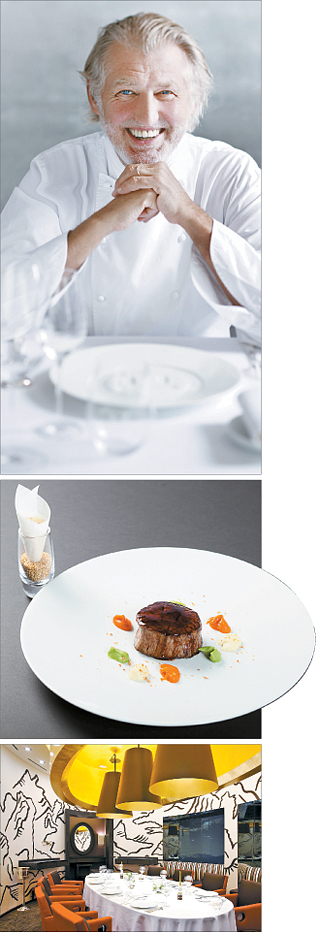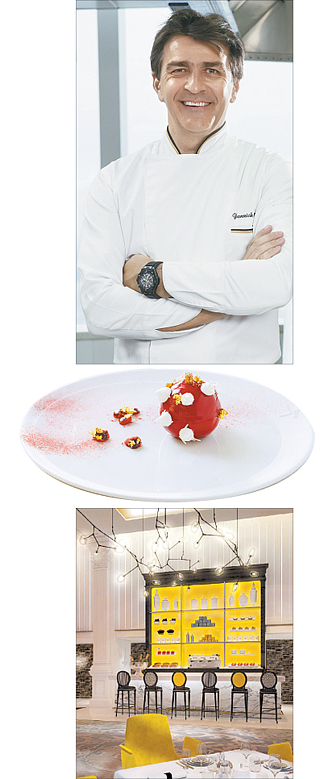French chefs shake up the Seoul food scene : Michelin star masters Pierre Gagnaire and Yannick Alleno discuss their work and dreams

It wouldn’t be an exaggeration to say that the opening of the restaurant has inspired many young chefs in Korea to dream about going overseas to study and work, and has also created a chance for local chefs to seek out ways to use locally available ingredients that were formerly rarely seen at restaurants.
About nine years after Gagnaire opened Pierre Gagnaire a Seoul, Korea now welcomes another Michelin star chef, Yannick Alleno of Ledoyen in Paris, with his new restaurant at Lotte Hotel’s Signiel in southern Seoul. Alleno has joined hands with the hotel to open a more casual restaurant chain called Stay.
The arrival of the new restaurant has many wondering what Alleno will bring to the local dining scene with his more casual and approachable style, especially as Gagnaire will be taking a break since Pierre Gagnaire a Seoul is undergoing renovation from July. The renovation is expected to last about one year and the hotel and Gagnaire are in talks on the possibility of continued business.
The Korea JoongAng Daily met with these two chefs to hear more about how the dining scene in Korea has been changed in the past and why the food and service industry is looking more and more promising for many international chefs.
Gagnaire shared how he has contributed to the dining scene here over a decade while Alleno discussed his ambition to start a new life in Seoul.

Chef Pierre Gagnaire, top, head of the eponymous restaurant in Lotte Hotel Seoul, central Seoul, has prepared his fine-dining menu since the opening of his restaurant nine years ago. The restaurant, above, will be renovated for about a year and the chef and hotel are in talks about continuing their business together. [LOTTE HOTELS AND RESORTS]
Chef Pierre Gagnaire is ending a story he started writing nine years ago as the first chef with three Michelin stars to open a restaurant in Seoul.
“We have built a strong story with the staff and the hotel,” said Gagnaire, “and to see the end of that story, I’m sad.”
The journey so far has not only been a dynamic one for him, but also for Korea’s dining scene.
At one time, there were few enough French restaurants in Seoul that they could be counted on one’s fingers, but now they are practically ubiquitous.
Gagnaire discovered many ingredients - ginseng, omija (a type of locally grown berry), makgeolli (a fermented rice drink) and so forth - while he was in Korea and then he took them to Paris where he served them in dishes to diners.
Just as Koreans slowly took to French ingredients, Parisians began to warm to Korean fare, which contributed to making Korean cuisine the talk of the town among chefs and food aficionados there.
“While Europe has many diners from different ethnic and cultural backgrounds, diners in Korea are relatively more homogenous, which makes it tougher for chefs to try new things,” said Gagnaire.
To check out the local food scene and how it is changing, he visited restaurants run by young talents.
Rather than being overly analytical, he tried to get a sense of the struggle local chefs have with monetary issues and team building.
To that end, he met with local chefs to discuss issues that arise when running a restaurant.
What he suggested as the new vision of food in the local scene is that dining at a restaurant should be more than just eating food, adding that dining experiences should become more like a show.
“[Dining] is a way to forget the world and to be focused in the very special atmosphere,” he said.
“You come to spend a good time at a restaurant, in the same way that you might go out one evening for a good piece of theater, or to see a movie, or read a book,” said the chef.
“The guests are the actors [who make the show] and the [restaurant staff] are like the audience.”
Chef Gagnaire said that there is a new generation of chefs in the Korean food scene who were all but invisible, or simply not here, when he came to the scene 10 years ago.
Since he “broke the ice and opened the door,” as he puts it, so that many chefs could entered the Korean food scene after him, there are now more opportunities for them to do what they want, and to help change and evolve the market - or, as he prefers to call it, the stage.
What they need to do to make their dining experience more like “a show,” he says, is “find the twist to their bibimbap.”
In other words, he encourages them to find their own colors, their own props, their own facial expressions or patterns, as it were, and to evolve from being too conservative in working with traditional recipes in the kitchen, or from simply mimicking what’s already been created and presented somewhere else in the world, to making something that truly thrills not only because it’s delicious but also because it offers an experience.
Those who try to find their own way, to carve their own path, will survive, he says, while the rest, who are content to be unoriginal, are always doomed to struggle or fade away.
“You must create the desire, and you must take great care to build a team,” he says.
“Spirit and connection to the city is so vital in opening a restaurant.”

Chef Yannick Alleno, top, head of the restaurant Stay at Signiel hotel in southern Seoul, and of the Michelin three-star restaurant Ledoyen in Paris, presents approachable French fare at Stay, above, which opened in April. The chef is getting acquainted with local ingredients to create familiar dishes that are still essentially French. [LOTTE HOTELS AND RESORTS]
Chef Yannick Alleno has written “a new love story” with the opening of Stay in Seoul last month.
The chef, who never visited the city before, has already made four trips.
“Korea makes me richer as a person,” he said as he explained that there is so much about Korean cooking that he never knew before but that is nevertheless quite similar in certain ways to French cooking.
Alleno therefore wants to take in as much as he can while he is here. He also hopes to pick up the food-preserving skills that have been handed down over the years in Korea.
Alleno said that in France, consuming food when fresh is key, so preserving it is rarely a needed skill, while here people eat kimchi that may have been aged for months or even a year almost every day.
“I can put garlic, vinegar and sugar and, say after 20, 30 or 40 years, that it’s preserved garlic by Yannick Alleno and give it as a present for others,” the chef said.
He also often reflects on the core idea of what drives the development of Korean cuisine.
He believes people in France are driven by the taste of food, while in Korea, and across Asia, other elements of a dish, such as nutritional factors, are what matter most.
“In France you work, love and live for pleasure, but in Asia people think a lot about health and [keeping your] body in good condition,” said Alleno.
“We have to share each other’s different experiences and get the taste of the future,” he continued, “so that we can hand down the heritage for the next generation of chefs.”
He has therefore decided to pursue “simplicity with complexity,” and he is trying to incorporate different ideas to produce an ultimately simple product on the plate.
Unlike Gagnaire’s fine dining approach, Alleno seeks to have the general public feel that French food is something approachable and not at all something difficult to understand or enjoy.
As a result, he focuses on getting himself more familiar, as much as he can, with what’s available here so that he can then use that information to be able to approach diners with items they have seen on their dining table before.
Sauce, for instance, one of the fundamental pillars of French cuisine, can be made with or be complemented with local ingredients.
“Modernization has made you see the same baguette whether you go to New York, Paris or Tokyo, but this is not really cool,” he said.
To keep that from happening, while at the same time spreading his style of French cooking, he has decided to open his casual dining restaurants in cities all across the world, with one of the most recent ones in Dubai.
To strike a balance between what’s French and what’s local, he uses local ingredients, making key sauces from his home country, as he believes sauces and condiments make up 80 percent of a dish, particularly if the dish is French.
To gain a better understanding of Korean food, he makes dishes for his Korean friends, as well.
He once made bibimbap as a special treat for his friend, the artist Lee Ufan, only to be told that it could not truly be called Korean. Lee came the next day bearing all kinds of vegetables and sauces necessary to make a true bibimbap.
“He taught me how to make rice, how to make things crunch, and how to make sauces and, since that day, I can say I know how to make bibimbap,” the chef said. “Finding out new ways of making things is always interesting.”
BY LEE SUN-MIN [summerlee@joongang.co.kr]










with the Korea JoongAng Daily
To write comments, please log in to one of the accounts.
Standards Board Policy (0/250자)